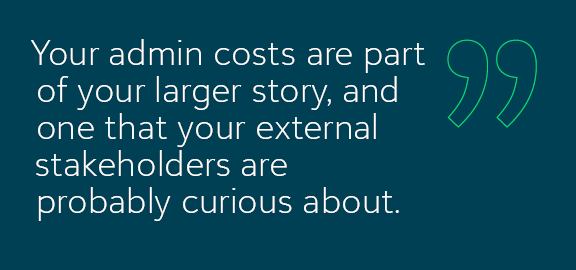What Are Admin Expenses?

I once interviewed for a job with an organization in Atlanta that sold coupon booklets door-to-door to support a children’s wheelchair basketball league. It sounded like a worthy cause, until I asked what percentage of sales actually went to the league. The answer was 7%. Ninety-three percent of the proceeds went to pay salaries and overhead for the organization doing the selling.
That sounds pretty terrible. But how can we know for sure?
It’s important to understand the different types of costs inherent in running a nonprofit organization, how those costs relate to each other, and what those costs indicate about your organization as compared to others. Fortunately, you can access verifiable, objective data—in your own fund accounting system and industry benchmarks—that will help illuminate your own costs.
Program Costs vs. Administrative Costs
Let’s look at two very different types of costs or expenses that your organization will incur: program costs vs. administrative costs.
- Program costs are why you exist as a nonprofit. This is the money that you spend to further your mission. It doesn’t matter if your mission is educating your members about the artwork in your museum, providing scholarships for children to attend your school, or buying warm coats for homeless families. When you spend money on those activities, you justify your own existence by improving your community.
- Administrative costs, on the other hand, are how you exist as a nonprofit. Admin costs are incurred as you direct and control the organization itself. They are also called “overhead” or, if you are working on a federal grant, “indirect costs.” Paying employee salaries, purchasing office supplies, and covering the electric bill so the lights keep working are all examples of the admin costs that you incur in the process of remaining a going concern.
How Much Should an Organization Spend on Admin Costs?
There is no federally mandated maximum percentage of total expenses that may be spent on administrative items, and different types of nonprofits will naturally incur admin costs at different rates.
So, how do you know if you’re spending “too much” or “just about enough” on admin costs? Charity Navigator’s latest Ratings Methodology, nonprofit CPAs, and other sources give us a consistent rule of thumb: ~70% or more of costs should be allocated to programs, leaving ~30% or less of costs allocated to administration. This can vary greatly, as we’ll explain below, but it’s an important starting point.
The most important variable is the type of organization you’re operating. Historically, the highest-overhead organizations are museums, which must pay to maintain their collections, and the lowest-overhead organizations are food banks, for which the greatest need is simply donated food. So, a museum that spends 15% of its total expenses on admin costs is doing very well at keeping costs low but may not be paying staff a livable wage or might be putting off costly repairs. A food bank spending the same 15% on admin costs, on the other hand, may be running less efficiently than the museum, or they may be focused on providing fresh, less processed food that requires more refrigeration, increasing utility costs.
Tell a Transparent Story About Your Admin Costs
As you evaluate your organization, remember that you’re not operating in a vacuum. Why you exist has a bearing on how you exist. It should go without saying, though, that in no case is it okay to allow your admin costs to hit 93% of total outlays, as in the organization selling coupon booklets I interviewed with!

Your admin costs are part of your larger story, and one that your external stakeholders are probably curious about. Obviously, your board and financial leadership should compare admin costs with program costs to ensure you’re properly fulfilling your mission. Additionally, savvy donors (not to mention the granting agencies) are keeping a close eye on the percentage of total expenses that nonprofits spend on admin, to ensure their funds are making a difference in their communities. Your organization should be able to generate, on demand, a Statement of Functional Expenses that clearly segments and analyzes admin costs.
Finally, don’t forget that some admin costs will be necessary. In years past, too often the focus from donors, ratings agencies, and others was simply “drive admin costs down as low as humanly possible regardless of other considerations.” Recently, however, we have seen a shift in thinking, and the realization that if we don’t pay competitive salaries and keep our utility bills up to date, for example, we won’t be in business for long, and then nobody in our community will benefit. So, determine what you’re currently spending on admin, and determine whether that percentage is reasonable given what other organizations of your type are doing. If your admin costs are already under control, then please continue to do a great job serving your community!
Want to learn how to get the reporting you need from your fund accounting system to clearly show donors and funders how their donations and grants are driving impact? Check out our white paper, 4 Benefits of Personalized Reporting.



